The global tea bags market was valued at $6.1 billion in 2021, and is projected to reach $12.9 billion by 2031, growing at a CAGR of 7.6% from 2022 to 2031.
Tea bags are the porous bag used to steep tea. It is sealed and filled with tea leaves. Tea bags have a string attached to make removing them from the brewing vessel easier, however, tea bags without string are also available. Growing popularity of the tea and demand for instant health benefiting drinks are majorly driving the growth of the tea bags market during the forecast period. Dynamic changes in consumption pattern and rise inclination of consumer from carbonated drinks to immunity boosting drinks are further anticipated to supplement the growth of the tea bags market.
Rise in number of cafes and restaurants with expansions of the metro cities are likely upsurge the demand for tea bags. Growing urbanization, expansions of the metro cities with growing demand for on trade instant tea and coffee are likely to supplement the growth of the tea bags market during the forecast period.
The retail industry is the economy sector that includes companies and individuals involved in selling of finished products and goods to end users. A wide range of tea bags and related products are sold through various retail channels such as hypermarkets, supermarkets, convenience stores, discounters, forecourt retailers, and grocery stores. Internet retailing, discounters, and convenience stores are the fastest growing retailers in the tea bags industry. These stores act as global marketing tools that assist in building an impressive premium image and increase brand exposure of a wide variety of tea and tea bags products. Hence, retail expansion is a significant factor that accelerates the tea bags market growth.
The demand for tea is driven by several health benefits associated with it, such as it is rich in antioxidants such as polyphenols, which majorly include flavonoids and catechins. These prevent large-scale cellular destruction via stabilization of harmful free radicals present in the human body. The nutritional composition of tea includes vitamins (C, K, B12, B6, and E), minerals (trace amount of potassium, manganese, magnesium, and calcium), and amino acids (L-theanine). Moreover, as per research conducted by different reputed organizations, Ready to drink tea is proven to prevent different types of cancers, lowers cholesterol, boosts immunity, facilitates weight loss, and prevent neurological diseases. Altogether, the abovementioned factors indicate that health benefits associated with tea drive the tea bags market growth.
Online retail is gaining significant popularity and is being used frequently to sell and buy products. The proliferation of smartphones and growing usage of social media nowadays are attracting alcoholic and non-alcoholic beverage manufacturers and advertising media companies to promote their products on social media. Large number of consumers, especially young population are present on social media platforms. Social media including Facebook and Instagram are very popular among young consumers. Thus, various brands including Lipton are using these social media platforms to build advertising campaigns for promotion and providing products through online platforms, including Amazon and their own websites. This, in turn, drives growth of the tea bags market.
The retail industry is the economy sector that includes companies and individuals involved in selling of finished products and goods to end users. A wide range of bubble tea and related products are sold through various retail channels such as hypermarkets, supermarkets, convenience stores, discounters, forecourt retailers, and grocery stores. Internet retailing, discounters, and convenience stores are the fastest growing retailers in the bubble tea industry. These stores act as global marketing tools that assist in building an impressive premium image and increase brand exposure of a wide variety of bubble tea products. Hence, the retail expansion is a significant factor that accelerates the market growth.
Most countries in the world have witnessed rapid urbanization and improvement in financial conditions. This has led to an overall rise in disposable income of people. In addition, this has made way for shift in consumer preferences, especially among young, aspirational drinkers in the developed economies such as Europe and North America, toward different and traditional beverages including refreshing beverages including tea. The population is gradually inkling toward healthy beverages. Tea is considered a healthy beverage since it contains a variety of powerful antioxidants as well as minerals including potassium, manganese, magnesium, and calcium. Thus, changing consumer preferences is expected to propel growth of tea bags market during the forecast period.
Coffee is an energizing beverage that contains different key nutrients, including potassium, manganese, magnesium, and niacin. Moreover, it has proven to lower the risk of type 2 diabetes, protect liver, and prevent certain type of cancers. These beneficial qualities of coffee makes it an easy substitute for tea. Coffee and coffee-related products such as cold coffee, café latte, and cappuccino also acts as refreshing drinks, similar to tea, thus can replace tea among consumers. Moreover, different surveys conducted among people by reputed organizations and increase in trend of out-of-home coffee consumption indicates the rise in coffee consumption over the past period. Thus, increase in coffee consumption is projected to hamper the product market.
Regular tea powder, unsweetened tea, yoghurt drinks, aloe vera juice, lemon water, coffee, and options such as ready to drink coffee, tea, and other beverages are major products considered to be substitutes for tea bags. Coffee and regular tea already gained major popularity among millennial population and it has become critically hard for tea bags to gain traction among these beverages. Furthermore, increase in consumption of healthy drinks for tea substitute such as lemon water, aloe vera juice, and yoghurt is expected to hamper growth of the product market during the forecast period.
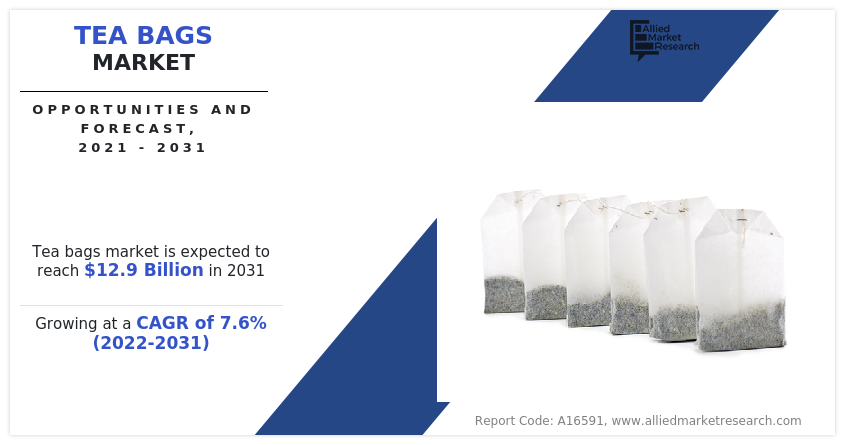
The market is segmented on the basis of type, distribution channel, application, shape and region. On the basis of type, the market is categorized into green tea, black tea, oolong tea, fruit and herbal tea and others. On the basis of distribution channel, it is segmented into supermarkets and hypermarkets, specialty stores, convenience stores, online stores and others. By application, it is segregated into residential and commercial. On the basis of shape, it is segmented into pillow shaped, round shaped, square shaped, pyramid shaped and others. Region wise, the market is analyzed across North America (the U.S., Canada, and Mexico), Europe (UK, Germany, France, Italy, Spain, Russia and Rest of Europe), Asia-Pacific (China, India, Japan, South Korea, Australia, Pakistan and Rest of the Asia-Pacific), and LAMEA (Brazil, South Africa, Turkey, Saudi Arabia, Egypt and Rest of LAMEA).
On the basis of type, the fruit and herbal tea segment was the considerable contributor to the tea bags market share, with $287.5 million in 2021, and is estimated to reach $609.7 million by 2031, at a CAGR of 7.6% during the forecast period. Fruit and herbal tea also known as tisanes is a kind of tea made from the infusion and decoction of a variety of herbs and spices. This tea is prized for its medicinal properties and is gaining traction in the global market. This segment is driven by increase in affinity of people toward herbal products. In addition, rise in number of tea drinkers and various health benefits associated with herbal tea has also been a detrimental factor behind growth of this segment in the global tea bags industry.
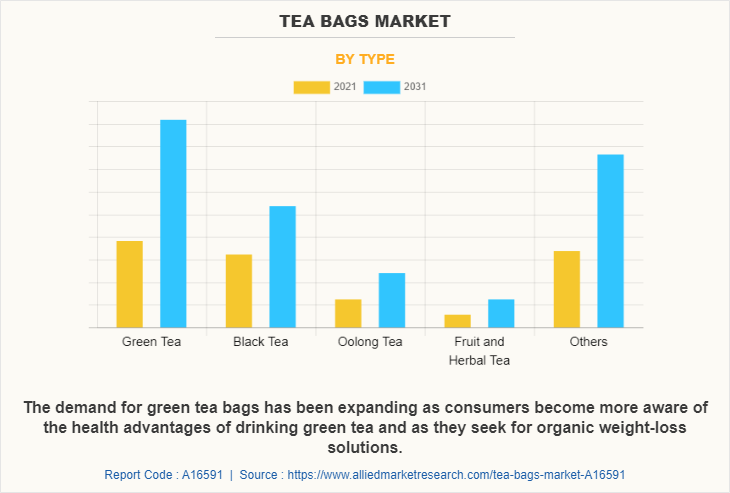
On the basis of distribution channel, the online stores segment was the most prominent segment accounting for the highest tea bags market share. Online distribution is one of the fast-emerging sales channels in the product market. Consumers prefer online platforms, owing to ease of accessibility and convenience. This platform offers a number of discounts on online purchase of tea to attract more customers. Emergence of advanced technology fosters growth of online business worldwide. Online sales has significantly contributed toward revenue of companies operating in the market. The key players are increasingly collaborating with e-commerce sites to improve their market presence.
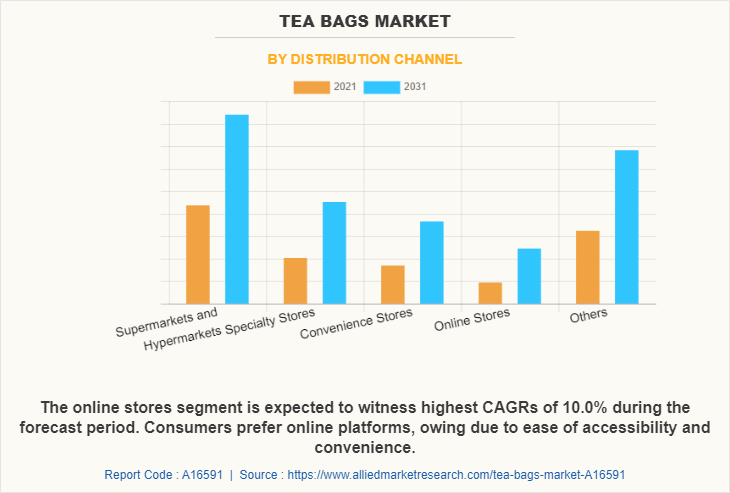
On the basis of application, the residential segment was the significant contributor to the tea bags market size, with $3,929.1 million in 2021, and is estimated to reach $7,809.5 million by 2031, at a CAGR of 6.9% during the forecast period. The residential segment includes common populace consuming tea at their residence. These users dominate the global market, owing to presence of large number of residences consuming tea for health and refreshment. Surge in consumption of caffeine beverages at home boosts the market growth in the residential segment. Moreover, rise in consumer awareness toward the health benefits of tea and extensive marketing & advertising by leading brands have shifted the consumer preference toward drinking tea, which drives the growth of the residential segment in global product market.
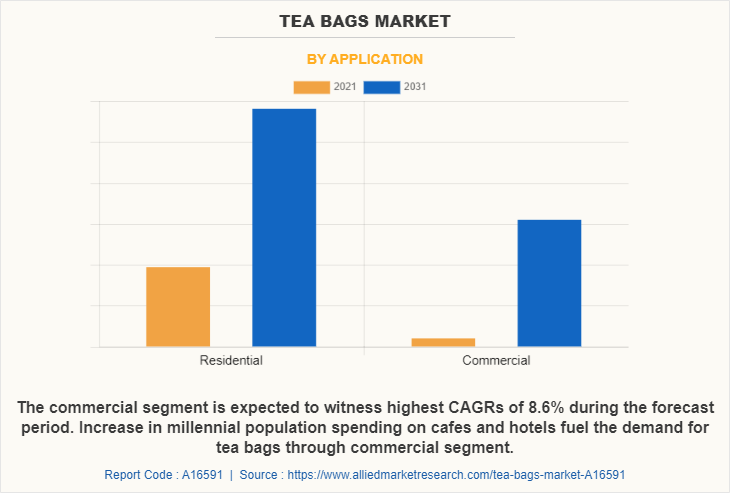
On the basis of shape, pyramid shaped tea bags has gained major share in global product market and it is anticipated to sustain its share throughout the tea bags market forecast period. This is majorly attributed to its benefits such as high infusion of flavors, provide convenience and availability of verity of flavors. Addition to that, Pyramid tea bags are more porous than regular tea bags. Hence brewing of tea is much quicker and the flavor release is easier. Available in Biomesh or Nylon based material, Pyramid Style Tea Sachets provide a great tea bag for flavor extraction of whole large leaf tea and herbs. The pyramid teabag allows for more effective and faster extraction. This is because the tea bag retains its 3 dimensional shape, so there is plenty of space for the tea leaves, and more of their surface area is exposed for extraction. Thus above mentioned factors are likely to boost the tea bags market demand during the forecast period.
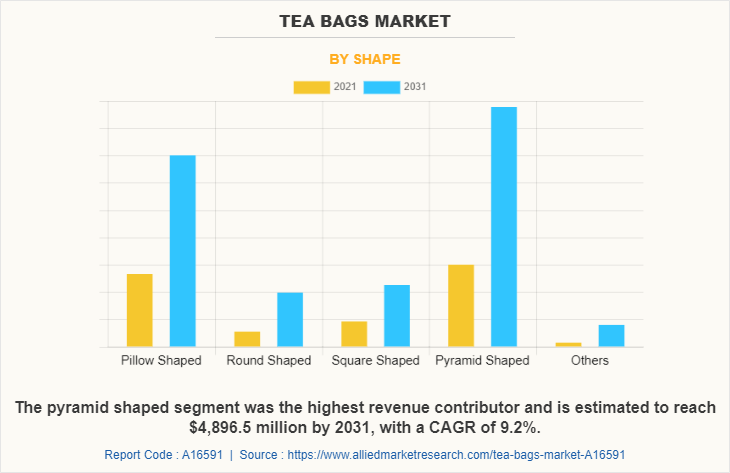
Region wise, Asia-Pacific garnered a highest share in the tea bags market in 2021, and is expected to increase its share throughout the tea bags market forecast period. Asia-Pacific garnered a highest share in the market in 2021, and is expected to increase its share during the forecast period. In Asia-Pacific, the tea bags market size is growing significantly, owing to highly prevalent tea culture in countries like China, India, and Japan. Black tea is anticipated to gain maximum demand in the region, compared to other segments, owing to high popularity and low price. Consumers have become health conscious and are attracted toward healthy products, which is also expected to boost the market for tea. Innovation in packaging and in taste and flavor is anticipated to unfold new business opportunities for the product market in the region.
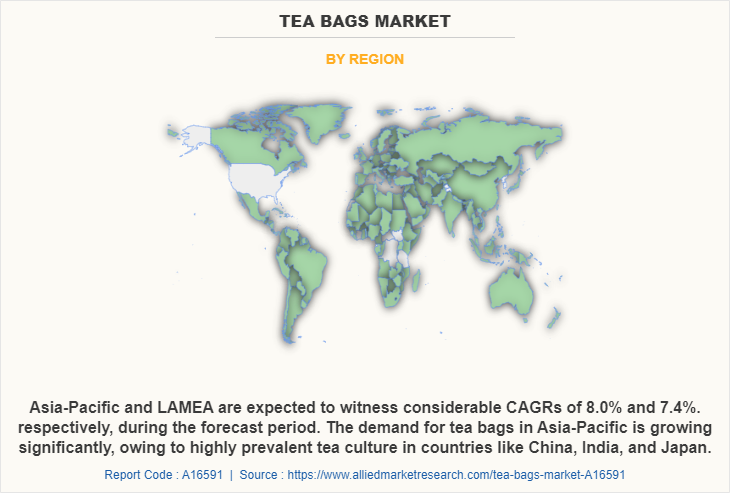
The players operating in the global product market have adopted various developmental strategies to expand their market share, increase profitability, and remain competitive in the market. The key players profiled in this report include Associated British Foods Plc., Barry's Tea, Nestle S.A., Northern Tea Merchants Ltd., Numi, Inc., Organic India, Tata Consumer Products, The Hain Celestial Group, Inc. and The Kroger Company and Unilever Plc..
Key Benefits For Stakeholders
- This report provides a quantitative analysis of the market segments, current trends, estimations, and dynamics of the tea bags market analysis from 2021 to 2031 to identify the prevailing tea bags market opportunities.
- The market research is offered along with information related to key drivers, restraints, and opportunities.
- Porter's five forces analysis highlights the potency of buyers and suppliers to enable stakeholders make profit-oriented business decisions and strengthen their supplier-buyer network.
- In-depth analysis of the tea bags market segmentation assists to determine the prevailing market opportunities.
- Major countries in each region are mapped according to their revenue contribution to the global market.
- Market player positioning facilitates benchmarking and provides a clear understanding of the present position of the market players.
- The report includes the analysis of the regional as well as global tea bags market trends, key players, market segments, application areas, and market growth strategies.
Tea Bags Market Report Highlights
| Aspects | Details |
| Market Size By 2031 | USD 12.9 billion |
| Growth Rate | CAGR of 7.6% |
| Forecast period | 2021 - 2031 |
| Report Pages | 415 |
| By Type |
|
| By Distribution Channel |
|
| By Application |
|
| By Shape |
|
| By Region |
|
| Key Market Players | Northern tea Merchants Ltd, Organic India, Tata Consumer Products, Unilever Plc, The Hain Celestial Group Inc, Nestle SA, Numi Organic Tea, Associated British Foods Plc, Barrys Tea, The Kroger Company |
Analyst Review
The global tea bags market is expected to grow significantly during the forecast period, owing to rising beverage consumption worldwide and growing preference for small capacity convenient providing tea bags. Increase demand for laminated paper bags is attributed to growing emphasis on high-quality tea packaging for preserving flavor. Expanding production and appetite for black tea, particularly in the U.S. and North America is poised to become a successful market for tea bags.
Strong presence of several industry participants and increase in R&D spending, Asia-Pacific is expected to witness significant demand for tea bags during the forecast period. Competitors in the tea bag sector rely heavily on strategic alliances, such as acquisitions, partnerships, and capacity expansions, as well as other marketing strategies to strengthen their market position and gain competitive advantages. Furthermore, new launches of specialty tea bags products innovative packaging and flavors, and the ones consisting of black & green leaves combination have are anticipated to offer potential growth opportunities for the global market growth during the forecast period. Expansions of metro cities, growth in disposable income and dynamic changes in beverages preference leads to generate demand for tea cafes/bars, which in turn propels growth of the market.
The global tea bags market was valued at $6.1 billion in 2021, and is projected to reach $12.9 billion by 2031
The global Tea Bags market is projected to grow at a compound annual growth rate of 7.6% from 2022 to 2031 $12.9 billion by 2031
The key players profiled in this report include Associated British Foods Plc., Barry's Tea, Nestle S.A., Northern Tea Merchants Ltd., Numi, Inc., Organic India, Tata Consumer Products, The Hain Celestial Group, Inc. and The Kroger Company and Unilever Plc..
Region wise, Asia-Pacific garnered a highest share in the tea bags market in 2021
Growing popularity of tea, demand for instant health-benefiting drinks, dynamic changes in consumption patterns, rise in the inclination of consumers towards immunity-boosting drinks, and the various health benefits associated with tea are majorly driving the growth of the tea bags market
Loading Table Of Content...



